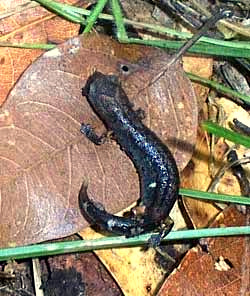Excerpts from Jim Conrad's
Naturalist Newsletter
from the July 20, 2007 Newsletter issued from Sierra Gorda Biosphere Reserve, QUERÉTARO, MÉXICO
RED-LEGGED FALSE-BROOK SALAMANDER
 At
dusk I pegged my tent beneath one of those relict-community Sweetgums I've told you about
present in this part of the world thanks to the last Ice Age. On that cool, moist
mountaintop the ground was carpeted with moss and when I got comfortable and sat looking
out my tent door I was thrilled to see a stubby- tailed, dark little salamander emerging
from the moss. Probably I'd disturbed him setting up the tent. As salamanders go he was
awfully small and at first I thought his tail was deformed because it was so short. But,
no, this species, about two inches long (5 cm) just had a real short tail. That's my
snapshot at the right.
At
dusk I pegged my tent beneath one of those relict-community Sweetgums I've told you about
present in this part of the world thanks to the last Ice Age. On that cool, moist
mountaintop the ground was carpeted with moss and when I got comfortable and sat looking
out my tent door I was thrilled to see a stubby- tailed, dark little salamander emerging
from the moss. Probably I'd disturbed him setting up the tent. As salamanders go he was
awfully small and at first I thought his tail was deformed because it was so short. But,
no, this species, about two inches long (5 cm) just had a real short tail. That's my
snapshot at the right.
At first I thought he was void of any decent field mark that would help me identify him, but then I saw it: Behind each tiny leg appeared patches of orange color, reminiscent of the leather elbow patches on coats favored by college professors back in the 60s.
I'm fairly sure this was PSEUDOEURYCEA CEPHALICA, subspecies RUBRIMEMBRIS*, endemic to a few states in upland northcentral Mexico and known in the literature as the Red-legged False-brook Salamander. At Mexico-Herps.Com I read that "Rubrimembris probably deserves species status, as it is quite distinct morphologically and displays an allopatric distribution from other cephalica ssp." "Allopatric" means "occurring in separate, nonoverlapping geographic areas," so this subspecies occurs in an island population separated from other members of the species, and if it's a species all by itself it's a narrow endemic.
What a treat seeing this little being occurring only in a tiny part of the whole world, and known to science so poorly that so far they can't judge whether our population represents a mere subspecies, or a whole different species all by itself.